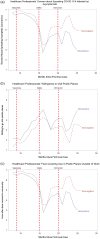SARS-CoV-2 seropositivity among healthcare professionals in a rural state
- PMID: 39465214
- PMCID: PMC11505257
- DOI: 10.1017/ash.2024.420
SARS-CoV-2 seropositivity among healthcare professionals in a rural state
Abstract
Objectives: We evaluated SARS-CoV-2 anti-nucleocapsid (anti-N) seroconversion and seroreversion rates, risk factors associated with SARS-CoV-2 seroconversion, and COVID-19 risk perceptions among academic healthcare center employees in a rural state.
Methods: Among employees aged ≥18 years who completed a screening survey (n = 1,377), we invited all respondents reporting previous COVID-19 (n = 85; 82 accepted) and a random selection of respondents not reporting previous COVID-19 (n = 370; 220 accepted) to participate. Participants completed surveys and provided blood samples at 3-month intervals (T0, T3, T6, T9). We used logistic regression to identify risk factors for seropositivity at T0.
Results: The cohort was primarily direct patient caregivers (205/302; 67.9%), white (278/302; 92.1%), and female (212/302; 70.2%). At T0, 86/302 (28.4%) participants were seropositive. Of the seronegative participants, 6/198 (3.0%), 6/183 (3.3%), and 14/180 (7.8%) had seroconverted at T3, T6, and T9, respectively. The overall seroreversion rate was 6.98% at T9. At T0, nursing staff (odds ratio [OR], 2.37; 95% confidence interval [CI], 1.08, 5.19) and being within six feet of a non-household member outside of work (OR, 2.91; 95% CI, 1.02, 8.33) had significantly higher odds of seropositivity. Vaccination (OR, 0.05; 95% CI, 0.02, 0.12) and face mask use (OR, 0.36; 95% CI, 0.17, 0.78) were protective.
Conclusions: The seroconversion and seroreversion rates were low among participants. Public health and infection prevention measures implemented early in the COVID-19 pandemic - vaccination, face mask use, and social distancing - were associated with significantly lower odds of SARS-CoV-2 seropositivity among participants.
© The Author(s) 2024.
Conflict of interest statement
BW, DK, AS, MAW, MDK, AMS, and JC report no conflicts of interest relevant to this article. DJD reports research funding from BioMerieux, Inc. and Affinity Biosensors. LH reports having receiving povidone iodine product for unrelated clinical trials from 3M and from PDI.
Figures


Similar articles
-
High anti-SARS-CoV-2 antibody seroconversion rates before the second wave in Manaus, Brazil, and the protective effect of social behaviour measures: results from the prospective DETECTCoV-19 cohort.Lancet Glob Health. 2021 Nov;9(11):e1508-e1516. doi: 10.1016/S2214-109X(21)00355-7. Lancet Glob Health. 2021. PMID: 34678195 Free PMC article.
-
Healthcare institutions' recommendation regarding the use of FFP-2 masks and SARS-CoV-2 seropositivity among healthcare workers: a multicenter longitudinal cohort study.Antimicrob Resist Infect Control. 2022 Jan 10;11(1):6. doi: 10.1186/s13756-021-01047-x. Antimicrob Resist Infect Control. 2022. PMID: 35012679 Free PMC article.
-
Seroprevalence of SARS-CoV-2-specific anti-spike IgM, IgG, and anti-nucleocapsid IgG antibodies during the second wave of the pandemic: A population-based cross-sectional survey across Kashmir, India.Front Public Health. 2022 Oct 6;10:967447. doi: 10.3389/fpubh.2022.967447. eCollection 2022. Front Public Health. 2022. PMID: 36276377 Free PMC article.
-
Quantification of Occupational and Community Risk Factors for SARS-CoV-2 Seropositivity Among Health Care Workers in a Large U.S. Health Care System.Ann Intern Med. 2021 May;174(5):649-654. doi: 10.7326/M20-7145. Epub 2021 Jan 29. Ann Intern Med. 2021. PMID: 33513035 Free PMC article.
-
Physical interventions to interrupt or reduce the spread of respiratory viruses.Cochrane Database Syst Rev. 2020 Nov 20;11(11):CD006207. doi: 10.1002/14651858.CD006207.pub5. Cochrane Database Syst Rev. 2020. Update in: Cochrane Database Syst Rev. 2023 Jan 30;1:CD006207. doi: 10.1002/14651858.CD006207.pub6. PMID: 33215698 Free PMC article. Updated.
References
-
- Bryan A, Tatem K, Diuguid-Gerber J, et al. Cross-sectional study evaluating the seroprevalence of SARS-CoV-2 antibodies among healthcare workers and factors associated with exposure during the first wave of the COVID-19 pandemic in New York. BMJ Open 2021;11:e053158. doi: 10.1136/bmjopen-2021-053158 - DOI - PMC - PubMed
LinkOut - more resources
Full Text Sources
Miscellaneous
